(v12.13.14)
Art, Architecture and Design
This article spotlights a particular building or some other aspect of Columbus design. I welcome your comments, corrections and additions. Please share your experience and perceptions of these uniquely Columbus projects.
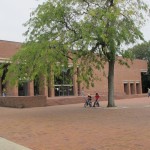 Cleo Rogers Memorial Library (Bartholomew County Library)
Cleo Rogers Memorial Library (Bartholomew County Library)
- Built: 1969
- Address: 536 5th Street
- Design Architect: I.M. Pei (I.M. Pei & Partners – NYC)
- Architect in Charge of Design & Production: Kenneth D.B. Carruthers(I.M. Pei & Partners – NYC)
- Structural Contractor: Weiskopf & Pickworth (NYC)
- Mechanical/Electrical Contractor: Segner and Dalton (White Plains, NY)
- Addition (1987) Architect: James K. Paris (Architect Group Inc. – Columbus, Indiana)
Cleo Rogers Memorial Library was designed by architect I. M. Pei who was chosen in 1963 for his total idea of an open-concept library surrounded by a public plaza in a neighborhood that would be easily accessible but away from heavy traffic areas. Phillip Johnson was also being strongly considered to design the building. Architect Irving Stone was another who was interviewed as part of the selection process. As originally envisioned the project was going to include an auditorium and perhaps a museum space as well but budget constraints limited the planning to the library. It might be noted that the library board also owns the adjacent site that houses the Columbus Visitors Center as well as the adjoining parking lot. The library board wanted the building to harmonize with its neighbors and create a unified civic space rather than just be an isolated architectural jewel.
Pei felt that the library should occupy a space which would be quiet, dignified, and easily accessible to persons of all ages. He also wanted the area around the library to create an urban space, which he felt was lacking in Columbus. His plan for the site moved the building back as far as possible and vacated the section of Lafayette Street between 5th and 6th Streets to create a large plaza along 5th Street in front of the library and next to the Irwin mansion. Brick pavers were used for the plaza chosen to harmonize with the colors of the Irwin House and First Christian Church. Pei recommended that a sculpture be commissioned for the plaza to act as a focal point or “conductor” of the varying architectural voices that surround you as you stand in the library plaza. He suggested that Henry Moore be considered. Pei compared his plaza idea to the public plazas found in European cities. Much of the design work can be attributed to Kenneth D.B. Carruthers who was Pei’s project manager for the library but it was clear that Pei was intimately involved with the design.
One of the reasons that the building fits so well with the surrounding buildings and neighborhood was the use of the “golden section” as a proportioning tool which was a concept used in historic architecture such as the Great Pyramid of Egypt and the Parthenon. It was used as well by French architect Le Corbusier in his design work. The golden section or golden mean is based on the mathematical value of PI and the square root of 5. It is often been called the “proportion of beauty” for it is also found in the human body and in nature. Carruthers was convinced that it was the reason the interior space so completely integrates with the exterior space and the surrounding neighborhood.
The library building is a sculptured brick pavilion with solid walls on the east and west. An integral concrete coffer slab and brick bearing wall construction are the main features of the design. Pei carefully chose the brick pattern and the way that the bricks intersected with one another: bricks were layed in the “Flemish Bond” pattern made up of alternating headers (short side of a brick facing out) and stretchers (long side of the brick facing out) on each course (row of bricks) with each header centered above and below a stretcher. The main entrance is located off center at the left side front of the building and set back along Fifth Street. The tall windows are deeply recessed, some have likened them as books on a shelf. The library blends in well with the surrounding neighborhood with the higher than necessary parapet wall to match the two story residential buildings on both sides. The parapet wall also hides the rooftop mechanical equipment. On the right side, the windows are lower in scale to align with the eaves of the Irwin House. Built towards the end of the modernist era, it exemplifies modernism with its pure geometric form and clean lines. Some have called it “subtractive” architecture as Pei started with a rectangular form and removed material (the recessed windows and doorways) to give it a still simple but very unique look. As opposed to the neighboring Victorian buildings which started with a rectangular form and gained their unique identity by the decorative elements applied to the exterior.
A curving poured concrete stairway inside leads to a small balcony/mezzanine level above the circulation desk with a skylight and plants and small trees at the center. This main stairway also leads to the lower level with an elevator available to all levels. The original building consisted of 87,000 square feet. The coffered concrete ceiling aids in acoustical control and houses lighting, heating and ventilating equipment. This poured concrete “waffled” ceiling is distinctive-looking and functional extending from the overhang at the entrance throughout the building. It can be seen on the lower level as well. The heat from the canister lights installed in the coffered ceiling is recycled through an elaborate intake/air handling system and used to heat the building during the winter months.
The childrens library and several meeting rooms, classrooms and offices are on the lower level with a separate entrance on the side. The adjacent parking lot includes a ramp leading to an underground storage area for the bookmobile with access to the inside of the library for easy loading. The lower level opens into a small terrace on the north side. A large flexible space on the lower level called the “Red Room” due to it’s bright red carpet can seat 150 and is often used for library sponsored lectures and programs. The lower level also contains the main home for the Columbus Indiana Architectural Archives (CIAA) dedicated to preserving the details of our unique architectural heritage.
An early library model showed a traditional statue of a soldier on horseback in the front plaza but it was apparently just a placeholder to mark the site for the sculpture. Pei desired a large sculpture as a counterpoint to the geometric forms of his modernist library and of the First Christian Church. What emerged later was the “Large Arch” designed by English sculptor Henry Moore. It stands on the site of the original 1903 Carnegie library which was demolished when the Pei building was completed. The sculpture was a gift from Mr. and Mrs. J. Irwin Miller who over the years had donated a number of statues and artwork to public buildings which wouldn’t have been possible in their building budgets. Over the years the Large Arch has quietly witnessed concerts, art festivals and other community events in the library plaza. One of the most popular events has been Popfest, a daylong annual event culminating in the Indianapolis Symphony playing on the steps of the library with the community filling the plaza, the street and the front of First Christian Church. Originated and sponsored by Salin Bank as a gift to the community, it is now on hiatus but perhaps will return.
‘Large Arch” was inspired by a visit to Stonehenge when Moore was a young sculptor. Moore had always wanted to create a sculpture like Stonehenge that people could walk around and through. He was 73 when he designed the sculpture. It’s a very organic form in direct contrast to the geometric shapes of the nearby buildings. He said that it represents the “primitive simplicity and power evident in monolithic sculpture of the past.” Fabricated of hollow bronze, it stands 20 feet tall, is 12 feet wide and weighs 5.5 tons. Moore designed it at his studio in England and had it sandcast in bronze in 50 sections in West Germany using the “lost-wax” casting method. The sections were a quarter to a half inch thick and the statue was given a pre-weathered natural looking green patina using a process developed and directed by Moore. “Large Arch” is a larger version of a sculpture called “Large Torso; Arch” which he made in 1962-1963 based on a male torso. Seven castings were made of this smaller arch including one in the sculpture court at the Museum of Modern Art (MOMA) in NYC and the San Francisco Museum of Modern Art. A copy of “Large Arch” was at Moore’s home called the Hoglands in Much Hadham, Hertfordshire, England.
The completed sculpture was shipped from West Germany to New Orleans by ship, transported on a barge to Louisville via the Mississippi and Ohio rivers and then sent to Columbus on the back of an oversized flatbed truck. Even turned on its side, the sculpture had to made some detours during the leg to Columbus as it wouldn’t fit underneath several overpasses along the way. The sculpture was specially placed on its site so that it would perfectly frame the bell tower of the First Christian Church if you stood just a foot away.
The Cleo Rogers Memorial Library took almost three years to complete after an initial 3 year design and fund-raising effort. Construction began in November of 1966 with the building opened to the public in October of 1969 with a community open house on December 7th, 1969. After the building was completed, the former library building was demolished and the plaza was completed along with the installation of the Henry Moore sculpture. Formal dedication of the building and plaza was held on May 16th, 1971 with architects I.M. Pei and Kenneth Carruthers in attendance. The building was named for Miss Cleo Rogers (1905-1964) to honor her 37 years of service to the library (28 years as head librarian).
The architects fees for the project were not paid for by the Cummins Foundation in this case but were directly funded by J. Irwin Miller as the family wanted to make sure that the project worked well with the Irwin House next door (the home to generations of the Irwin-Sweeney- Miller family) and the First Christian Church across the street which the family had funded in the 40’s. The building project was financed with a bond issue, a community fund raising drive and the Miller family donated the Henry Moore sculpture. Although the library was not part of the Cummins Foundation Architecture program, the foundation made a sizable donation to the building fund. Costs for the project spiraled past the planned budget and once again J. Irwin Miller stepped in to quietly make up the deficit.
An addition designed by local architect Jim Paris was added in 1987. Paris consulted with Pei on the design which he perhaps playfully rejected telling us to build another building if we needed more space. What he did ask for was a design that was distinctly separate yet complementary to his original design. Paris’s addition was over the original basement level in the rear containing the children’s library and the “Red Room” meeting space. He separated his one story, 11,700 square foot addition from the original Pei design with a two story skylighted gallery. It adds an interesting touch that the original exterior rear wall is now an inside wall. Pei was believed to be happy with the result. The addition was opened on June 16th, 1987.
The library has proven extremely flexible over the years as the collections have moved and services added to better serve the community as well as embrace the new media and computer services. It is well used by the community with services including computer access, DVD videos and CD music loans, talking books, as well as traditional books and periodicals. They are also now providing access to downloadable ebooks and a free downloadable music service. The library offers a regular program of lectures and classes on a wide variety of topics to serve the community.
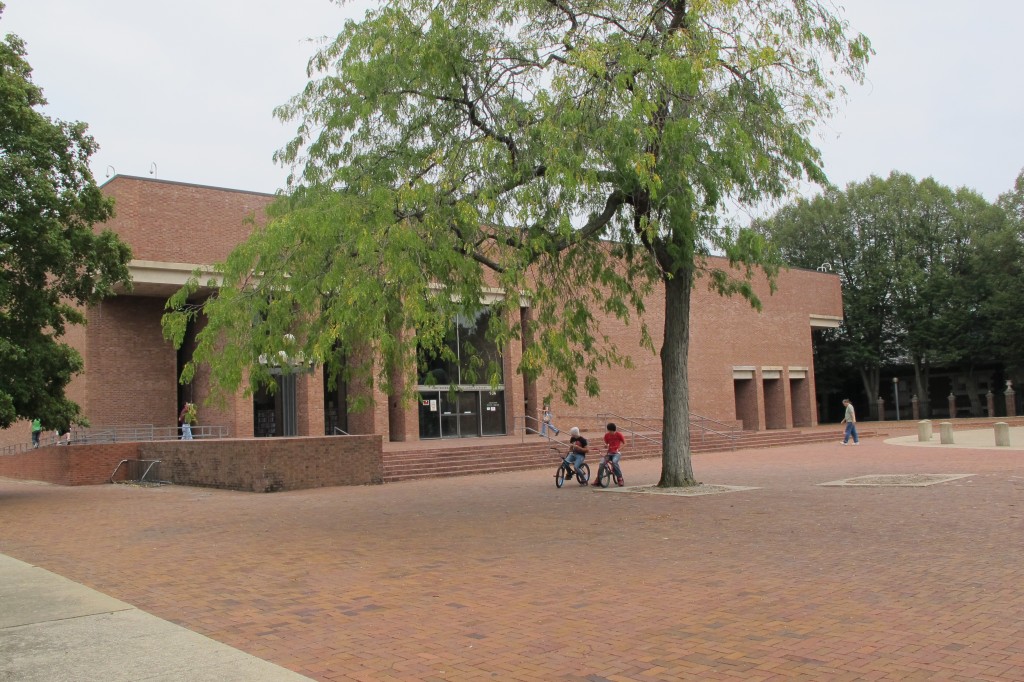 Cleo Rogers Memorial Library
Cleo Rogers Memorial Library
(photo by Ricky Berkey)
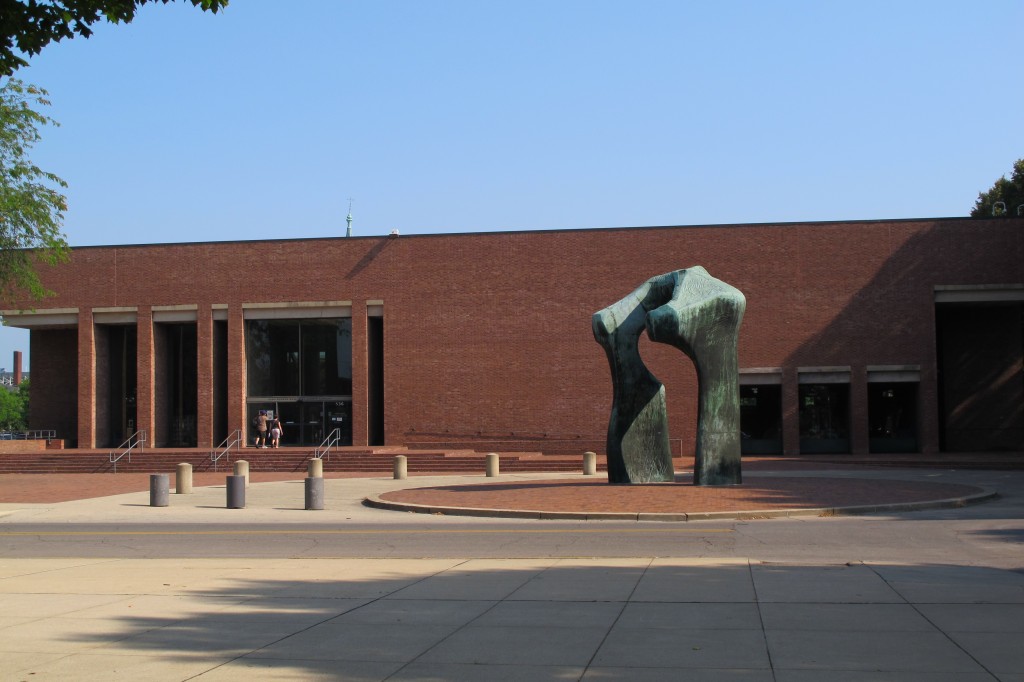 Front view
Front view
(photo by Ricky Berkey)
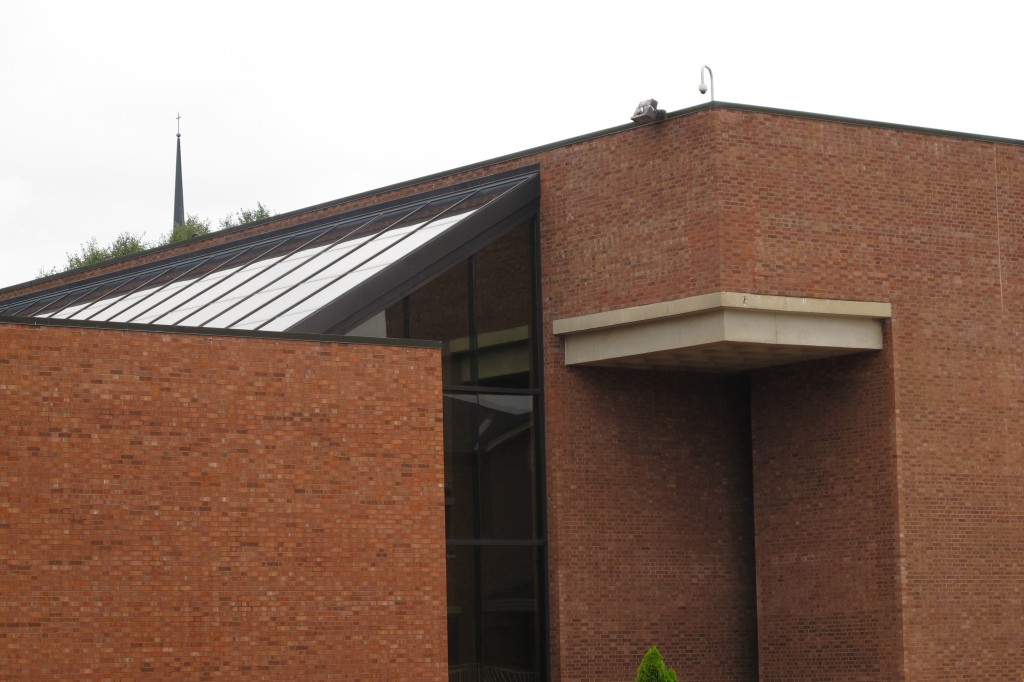 1987 addition on left, 1969 original on right
1987 addition on left, 1969 original on right
(photo by Ricky Berkey)
 1987 addition on left, 1969 original on right
1987 addition on left, 1969 original on right
(photo by Ricky Berkey)
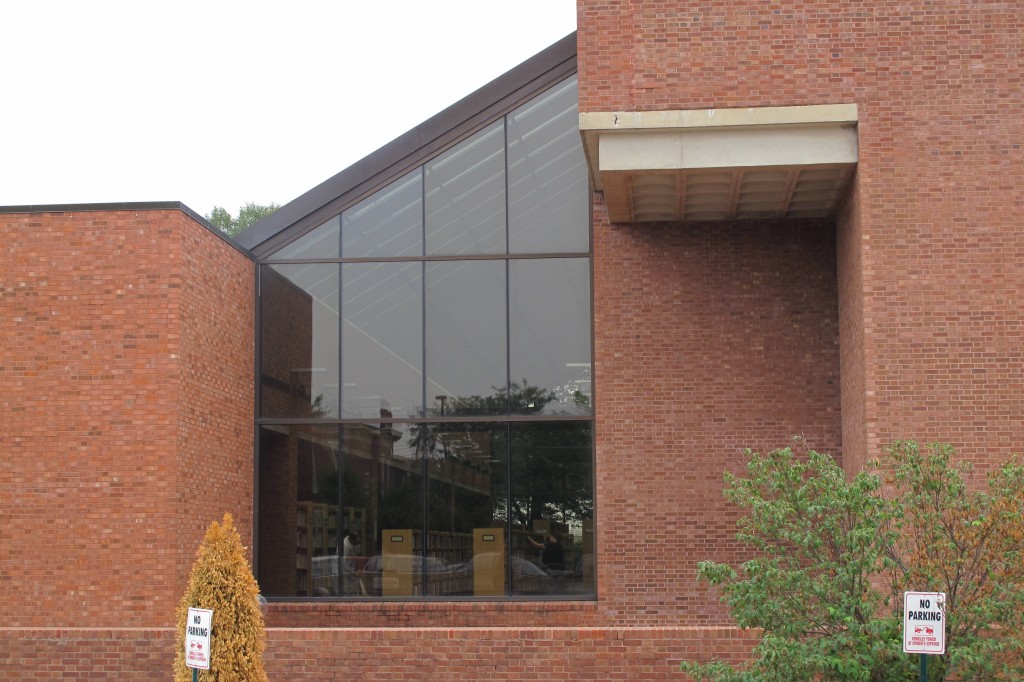 Glass gallery is part of the 1987 Jim Paris addition
Glass gallery is part of the 1987 Jim Paris addition
(photo by Ricky Berkey)
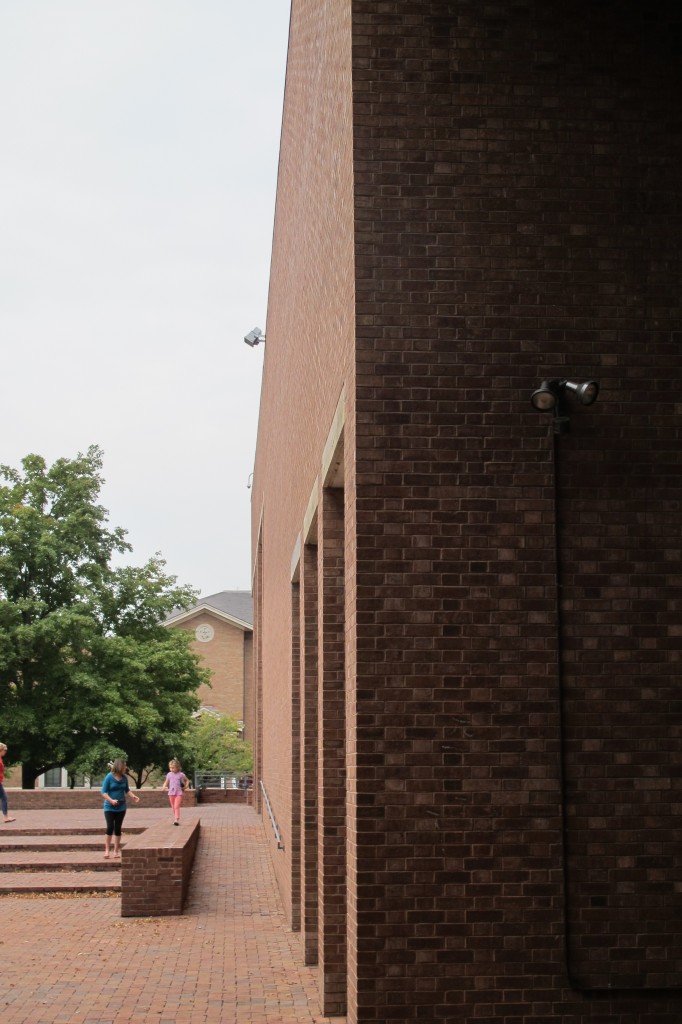 Front edge of building from the right side
Front edge of building from the right side
(photo by Ricky Berkey)
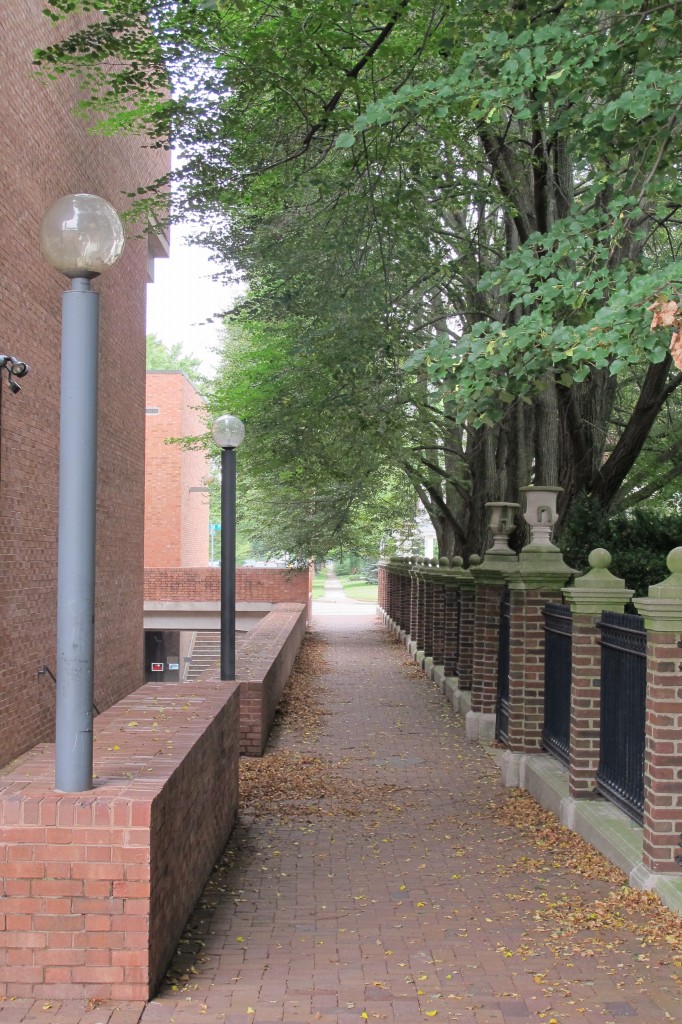 Right side of building next to the Irwin House
Right side of building next to the Irwin House
(photo by Ricky Berkey)
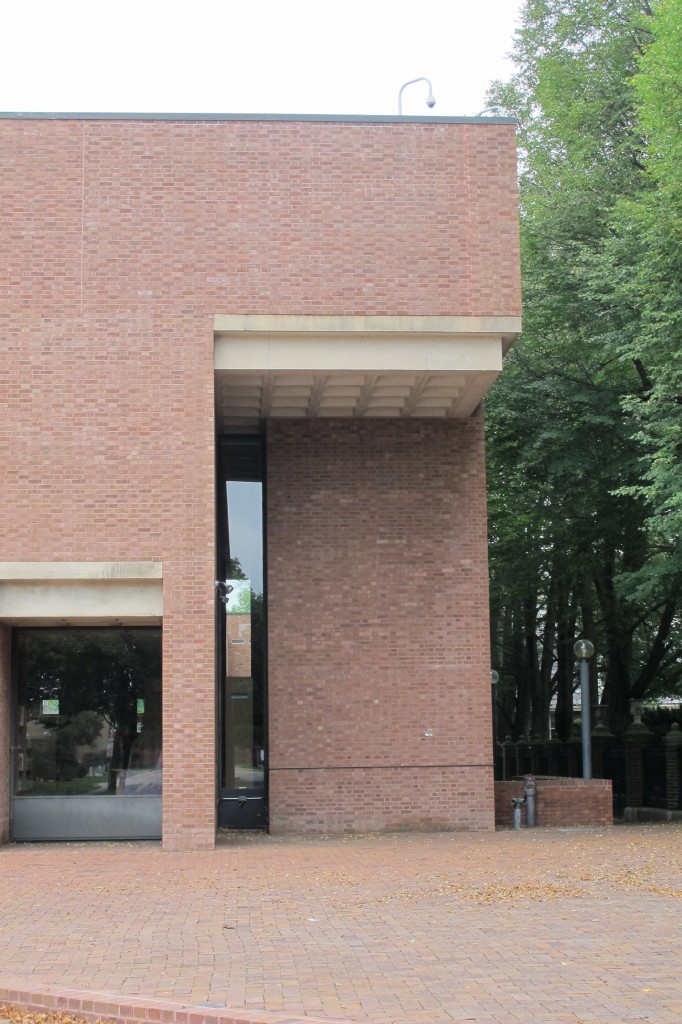 Front right side of building next to the Irwin House
Front right side of building next to the Irwin House
(photo by Ricky Berkey)
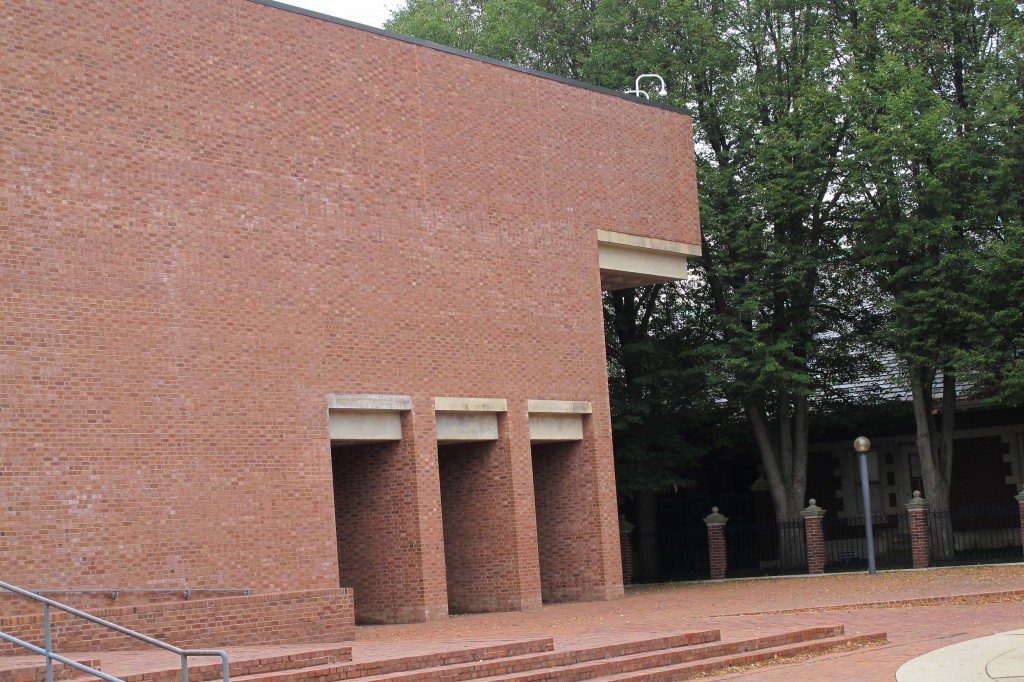 Front right side of library next to the Irwin House
Front right side of library next to the Irwin House
(photo by Ricky Berkey)
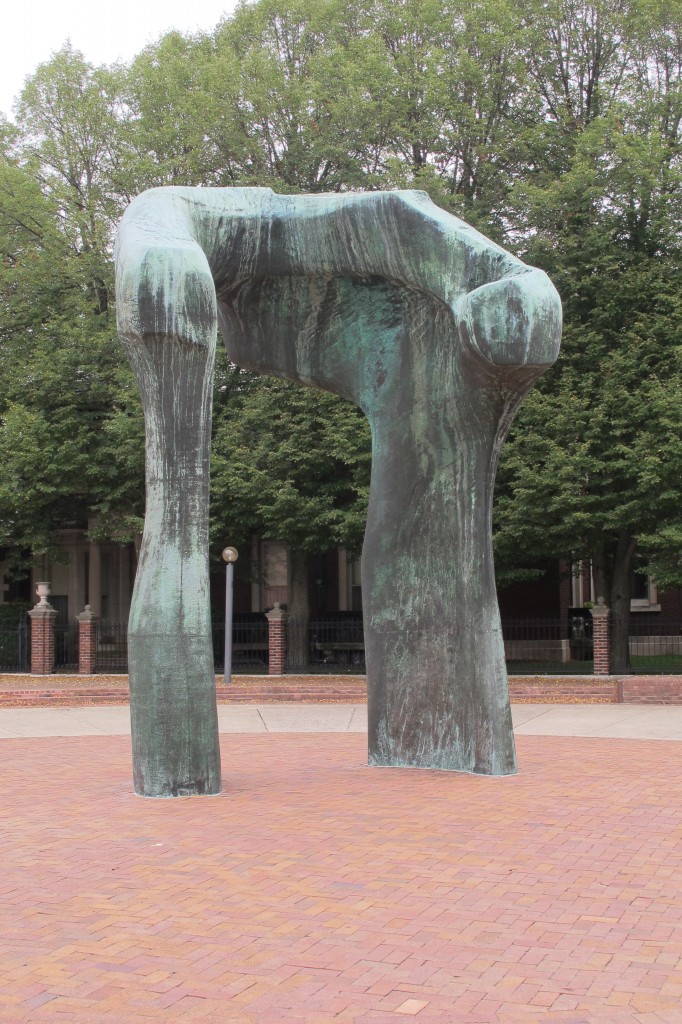 “Large Arch” by Henry Moore
“Large Arch” by Henry Moore
(photo by Ricky Berkey)
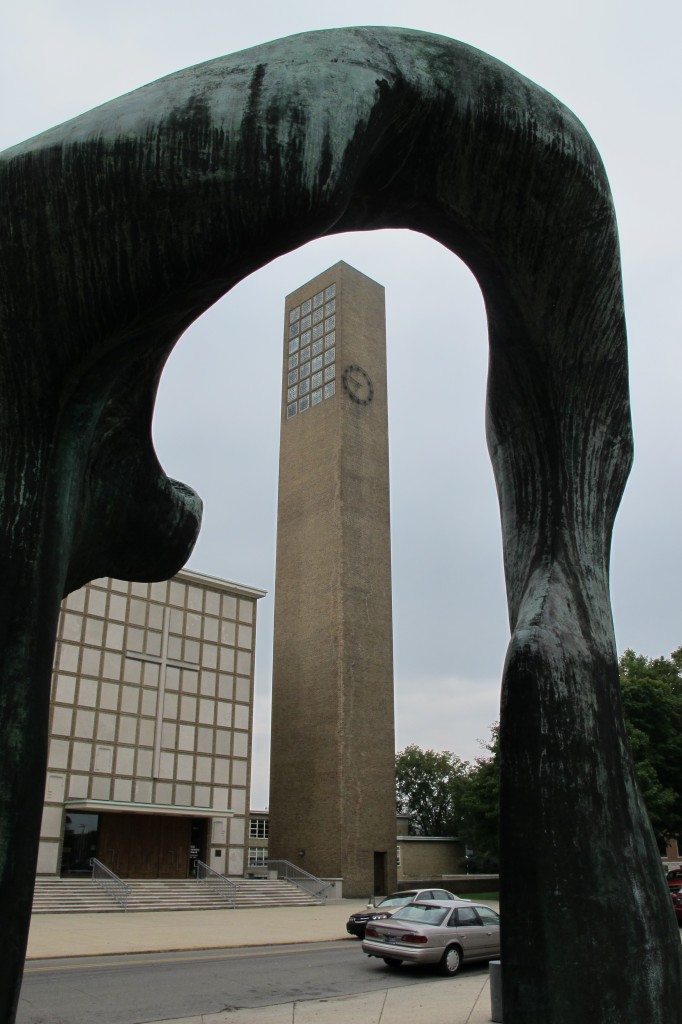 First Christian bell tower seen through “Large Arch”
First Christian bell tower seen through “Large Arch”
(photo by Ricky Berkey)
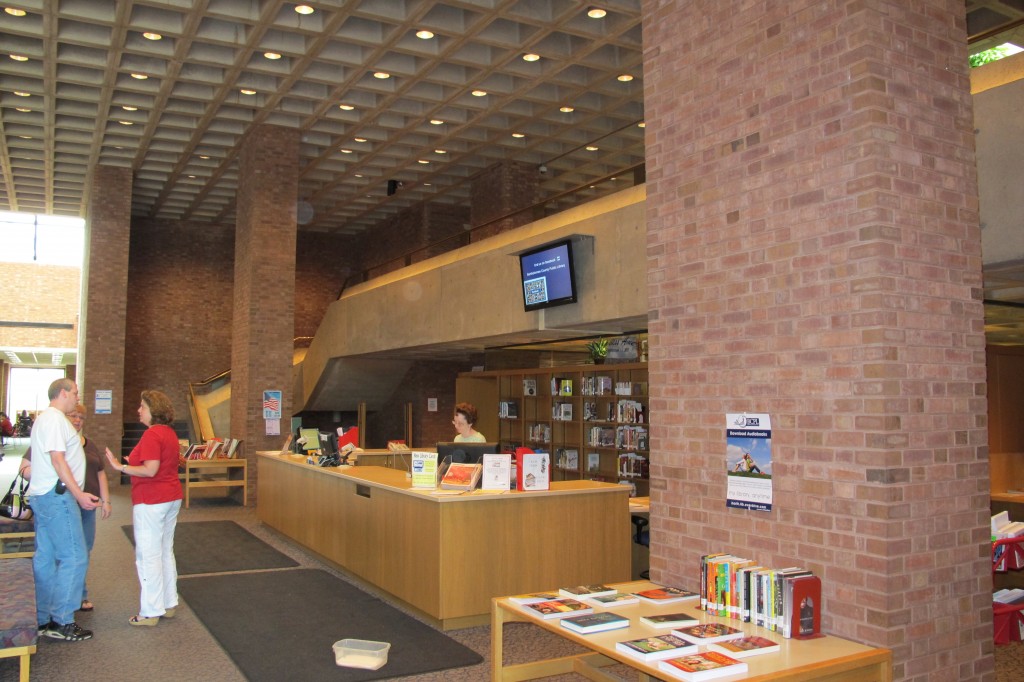 Circulation desk
Circulation desk
(photo by Ricky Berkey)
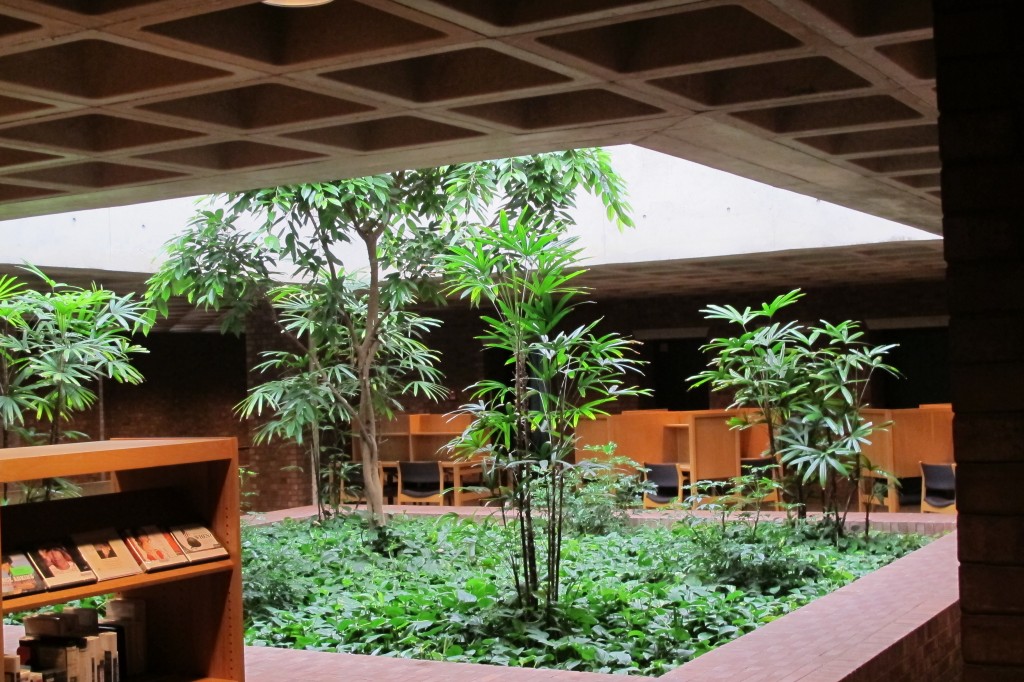 Upper level mezzanine
Upper level mezzanine
(photo by Ricky Berkey)
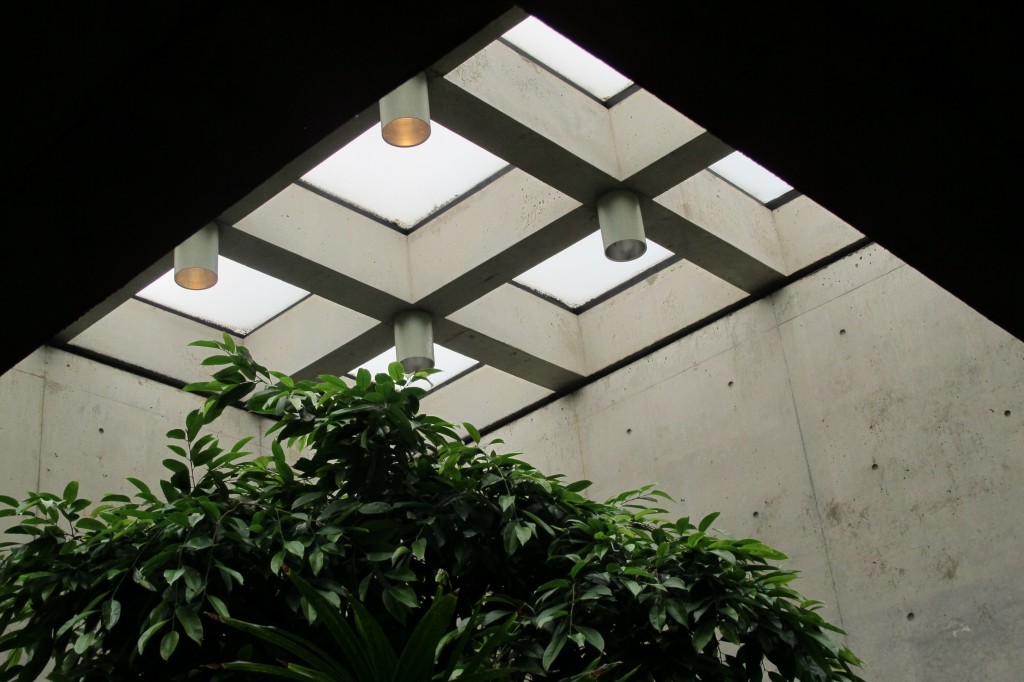 Skylight in the upper level mezzanine
Skylight in the upper level mezzanine
(photo by Ricky Berkey)
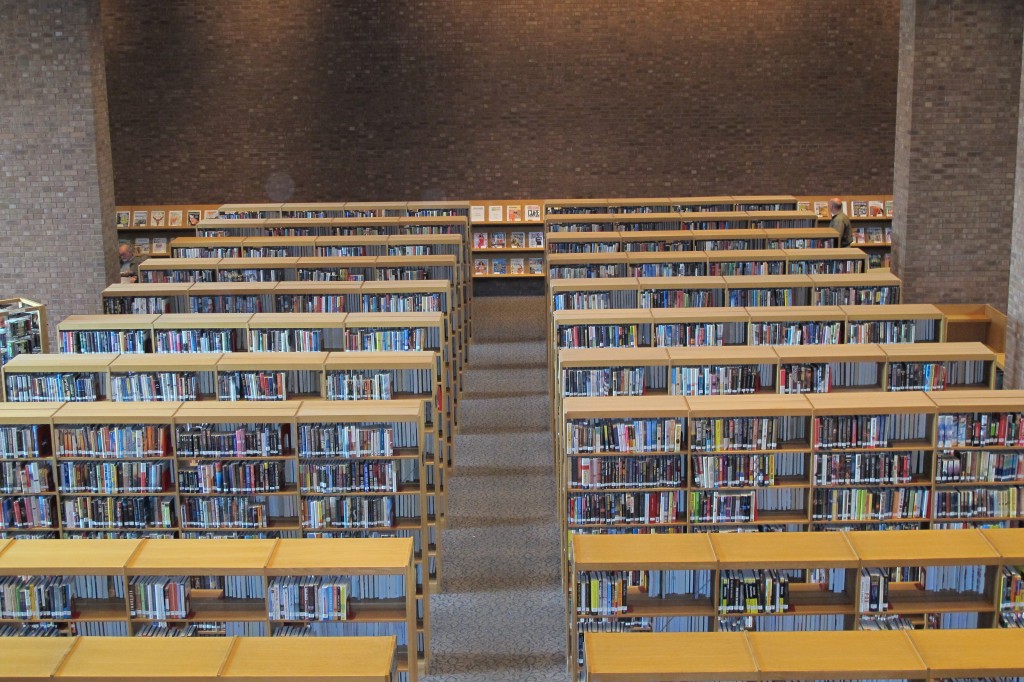 The “stacks” from the mezzanine level
The “stacks” from the mezzanine level
(photo by Ricky Berkey)
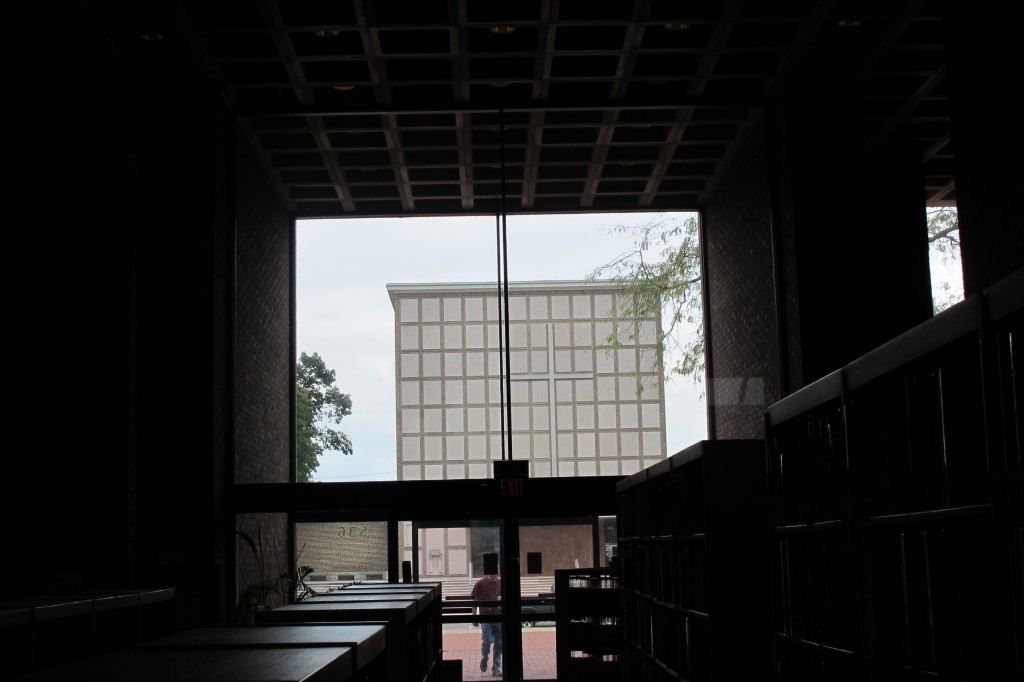 View of First Christian from inside library
View of First Christian from inside library
(photo by Ricky Berkey)
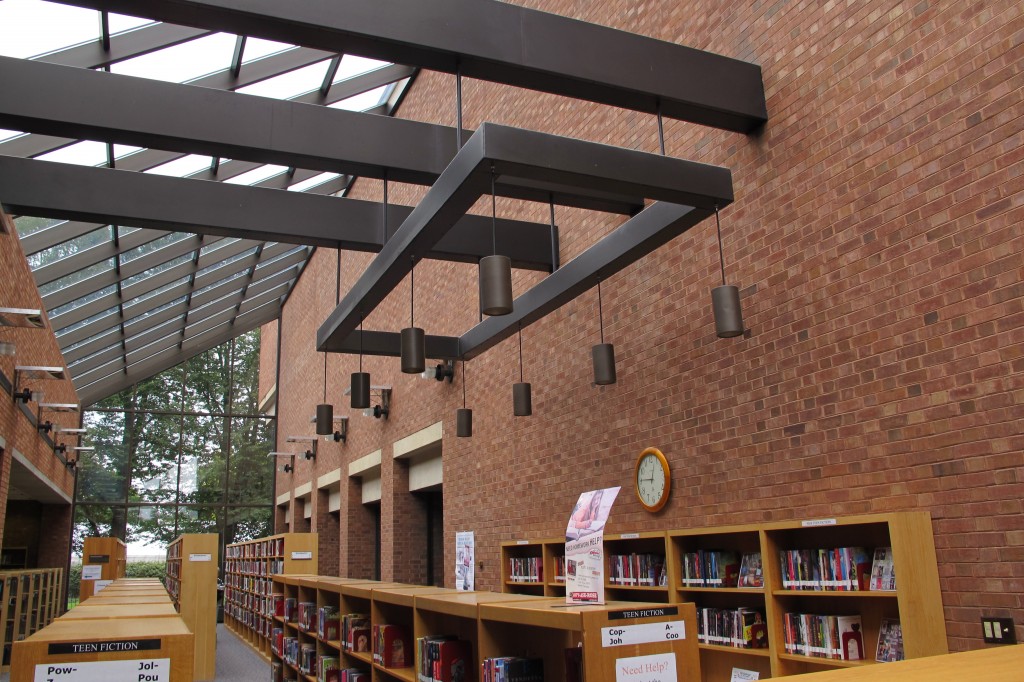 Inside the glass gallery of the Jim Paris addition, the wall on the right is the original Pei exterior wall
Inside the glass gallery of the Jim Paris addition, the wall on the right is the original Pei exterior wall
(photo by Ricky Berkey)
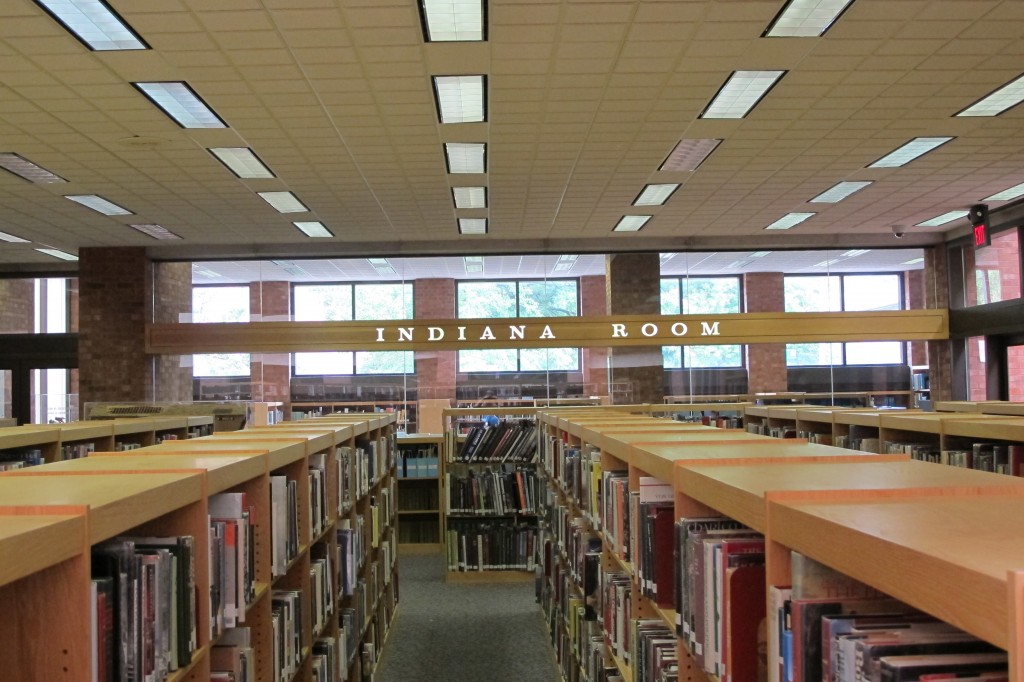 Inside the Jim Paris addition looking toward the “Indiana Room” (showcasing local and Indiana history resources)
Inside the Jim Paris addition looking toward the “Indiana Room” (showcasing local and Indiana history resources)
(photo by Ricky Berkey)
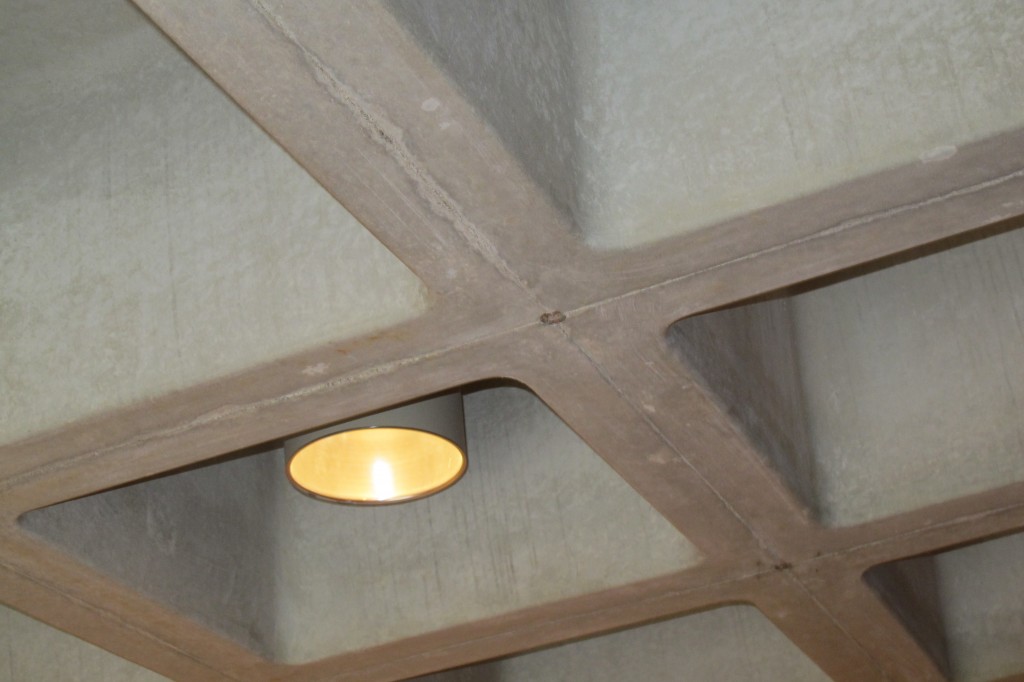 Closeup of the concrete coffered ceiling
Closeup of the concrete coffered ceiling
(photo by Ricky Berkey)
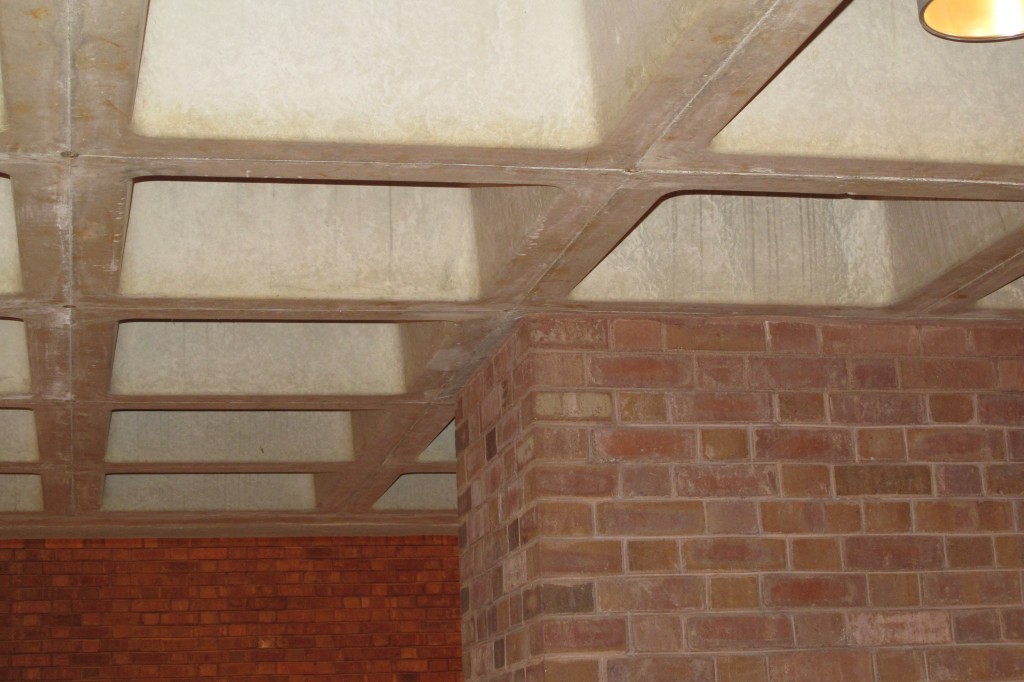 Brick column meeting concrete coffered ceiling
Brick column meeting concrete coffered ceiling
(photo by Ricky Berkey)
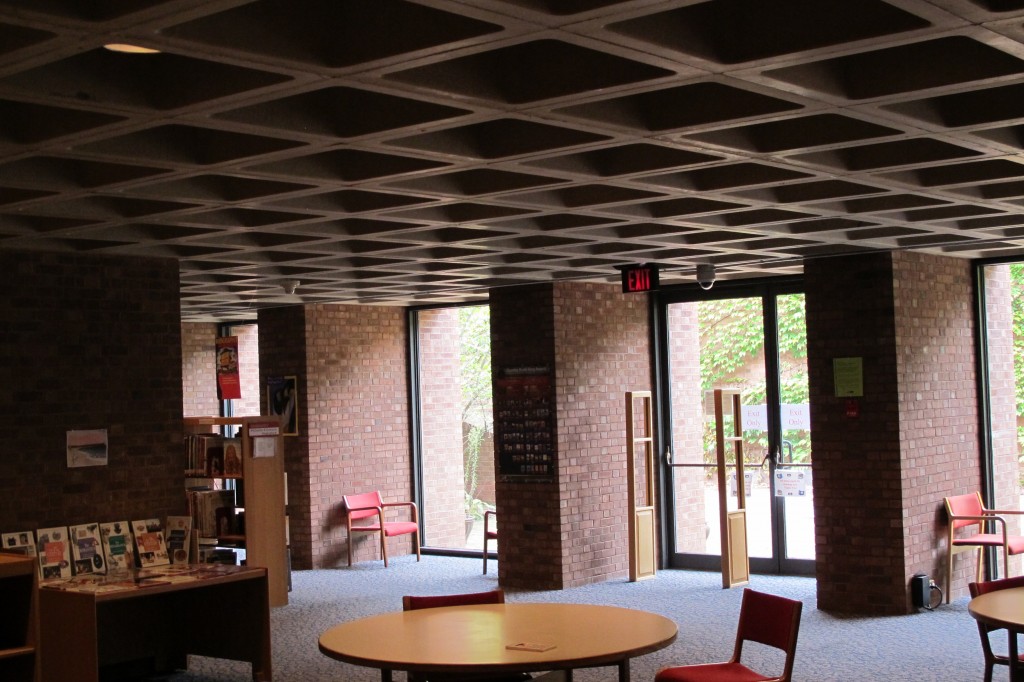 Lower level childrens area
Lower level childrens area
(photo by Ricky Berkey)
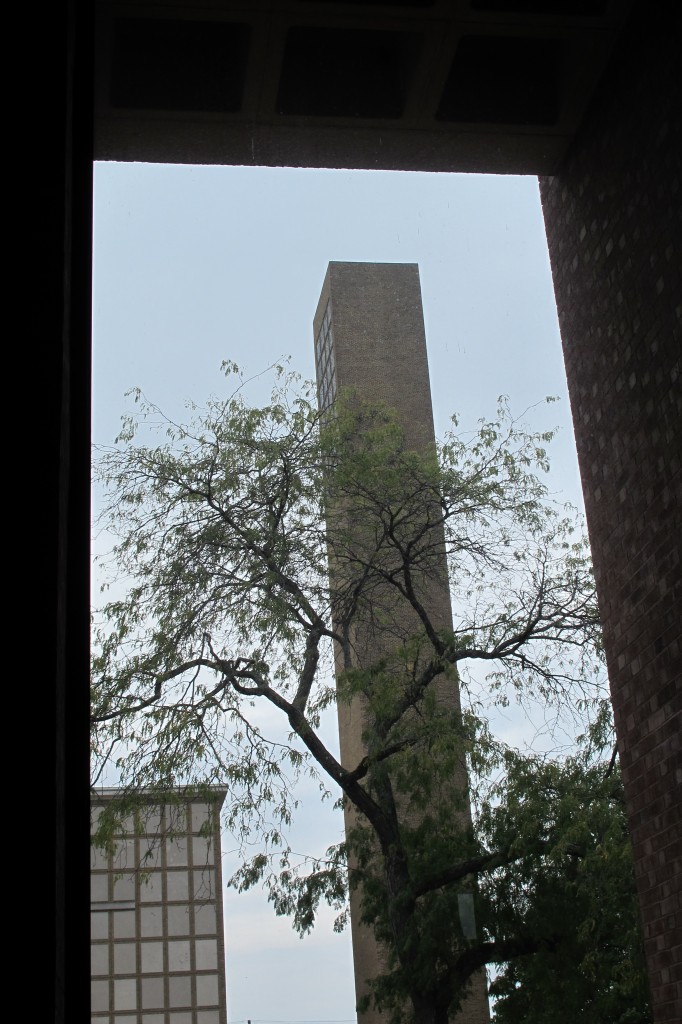 View of First Christian bell tower from inside front library window
View of First Christian bell tower from inside front library window
(photo by Ricky Berkey)
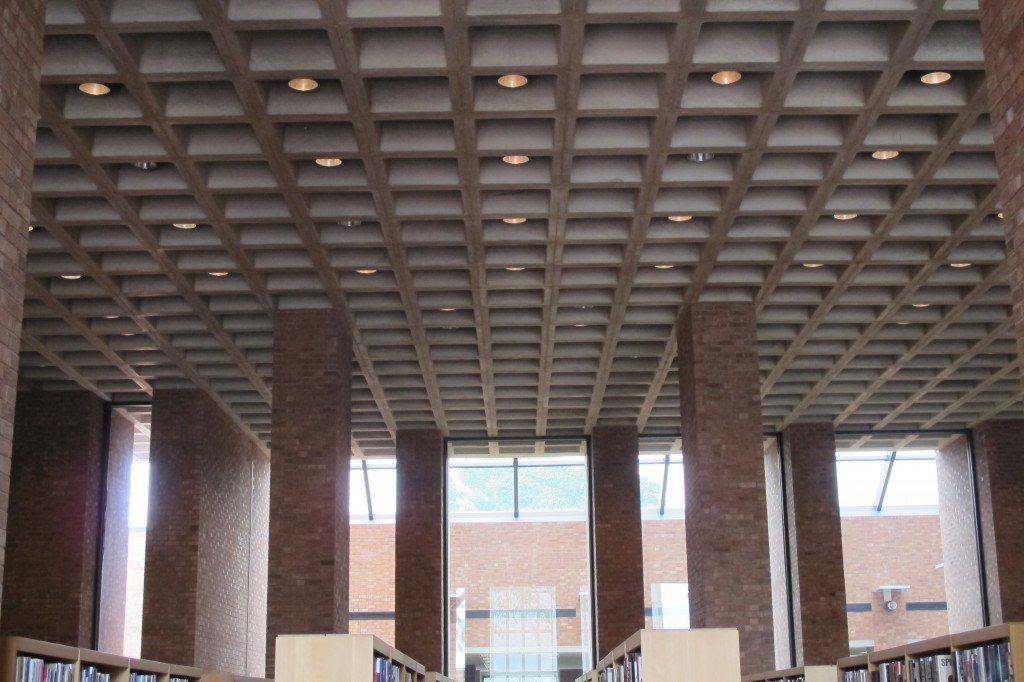 Brick columns and coffered ceiling looking toward addition
Brick columns and coffered ceiling looking toward addition
(photo by Ricky Berkey)
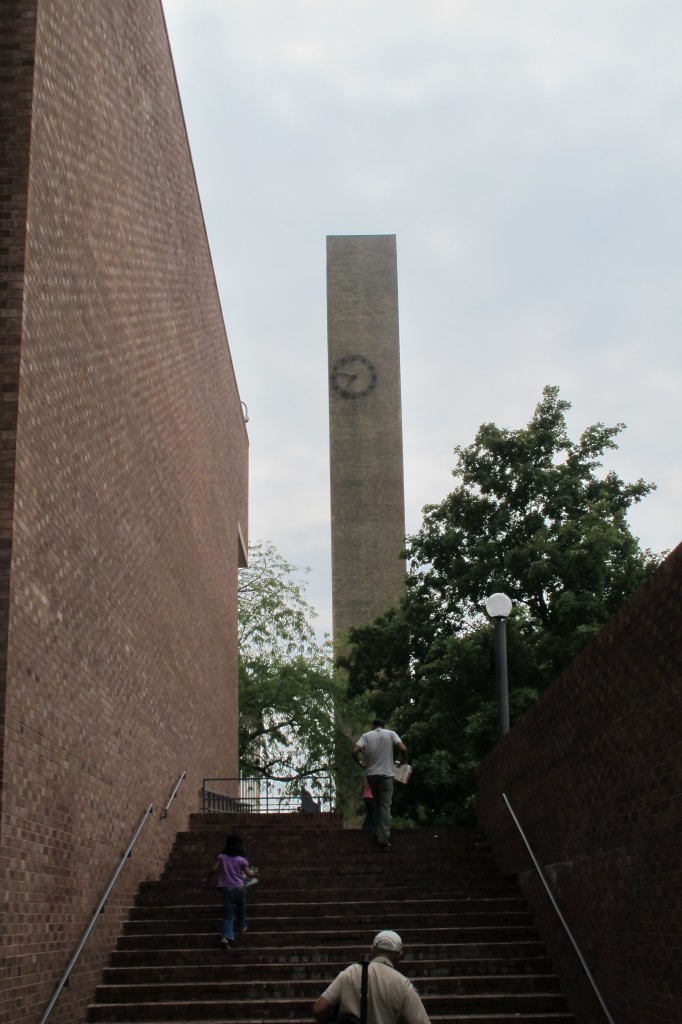 View of First Christian bell tower seen from the outside stairway from the lower level
View of First Christian bell tower seen from the outside stairway from the lower level
(photo by Ricky Berkey)
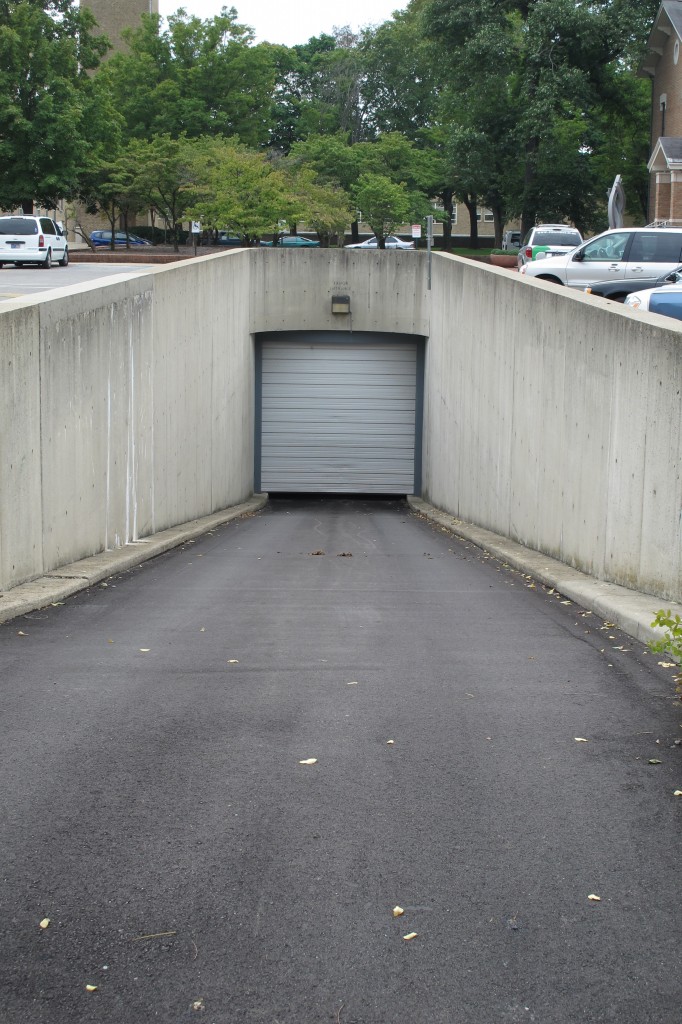 Ramp to the underground bookmobile storage and loading area
Ramp to the underground bookmobile storage and loading area
(photo by Ricky Berkey)
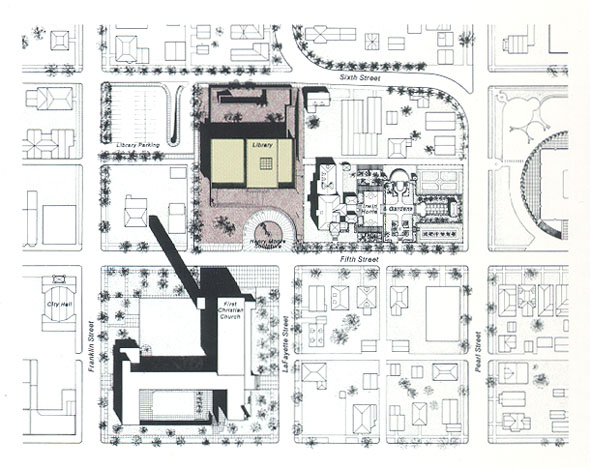 Site plan of the 1969 library in context with the surrounding neighborhood
Site plan of the 1969 library in context with the surrounding neighborhood
(graphic from the Pei Cobb Freed website, used pending permission)
The Architects
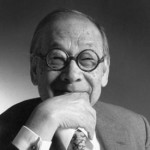 Ioeh Ming Pei
Ioeh Ming Pei
- Born on April 26th, 1917 in Guanzhou (Canton), China
- Philadelphia Institute of Technology (1934)
- Massachusetts Institute of Technology (MIT) (1940)
- Harvard University(1946)
-
Honors
- Architectural Firm of the Year Award – American Institute of Architects (AIA)(1968)
- Pritzker Prize for Architecture (1983)
- Gold Medal Award from the American Institute of Architects (AIA) (1979)
I.M. Pei was born in China in 1917 to an affluent family. The family had lived in Suzhou, a canal city, for over 600 years. His father was a banker with the Bank of China prior to Mao’s “Cultural Revolution”. His father moved the family to several towns in the southern part of China during his banking career, including Shanghai. Pei was exposed to a very cosmopolitan environment and was educated in a Christian school where he had the chance to interact with many foreign children.
Although his father tried to persuade him to further his education in England, Pei convinced him to allow his coming to the United States in 1934 at the age of 17. He studied briefly at the Philadelphia Institute of Technology before obtaining degrees from the Massachusetts Institute of Technology and Harvard. He studied under Walter Gropius at the Harvard School of Design. During WW2, he volunteered his services with the National Defense Research Committee in Princeton where he analyzed European bridges to locate weaknesses that might provide useful information for Allied bombing raids. He returned to Harvard in 1944 completing his Masters degree in 1946 while also serving as an assistant professor from 1945-1948.
In 1948, NYC real estate developer William Zeckendorf invited Pei to accept the newly created post of Director of Architecture at Webb & Knapp, resulting in many larges scale architectural and planning projects across the country specializing in low income housing. Pei became a naturalized citizen of the United States in 1954. In 1955 he formed his own architectural firm as I. M. Pei & Associates, which became I. M. Pei & Partners in 1966, and Pei Cobb Freed & Partners in 1989.
The partnership received the 1968 Architectural Firm Award of the American Institute of Architects. Pei was the recipient of the Pritzker Prize for Architecture in 1983. Pei used the Pritzer Prize award to establish a scholarship for Chinese students to study architecture in the United States with the proviso that they must return home to practice in China. Pei has received honorary degrees from numerous universities. On July 4, 1986, he was one of twelve naturalized American citizens to receive the Medal of Liberty from President Ronald Reagan. In 1988 he was inducted into the French Legion of Honor. In 1979 he recieved the Gold Medal Award from the American Institute of Architecture , their highest honor. His other awards are too numerous to detail here.
Pei’s father had fallen out of favor with the new Communist government in China and lost both his position and status in the society. It was ironic then when Pei was later asked to design Bank of China buildings in Hong Kong and Bejing. Two of Pei’s sons assisted him on the project. He also designed a hotel in Bejing and an art museum in his hometown of Suzhou incorporating traditional Chinese designs into a very modern building project.
One of his most controversial but celebrated designs was the addition to the Louvre in Paris where he blended an extremely modern building into the historic art gallery.
He married Eileen Loo in 1942 and has three sons and a daughter. Two of his sons have become architects. Although officially retired in 1990, he still maintains an office at Pei Cobb Freed and Partners. He has designed 26 major projects since turning 70 and 15 since turning 80. Pei has been described as a man of small stature (barely over 5 feet) yet with a commanding presence that could dominate any room with his sense of humor and quiet elegance and self-confidence.
Selected I.M. Pei Projects
1951: Roosevelt Field Mall – Garden City, New York
1962: Kennedy Theater at the University of Hawaii – Honolulu, Hawaii
1964: Green Building at the Massachusetts Institute of Technology (MIT)
1965: Century Towers – Los Angeles, California
1968: Des Moines Art Center (sculpture wing) – Des Moines, Iowa
1968: Everson Museum of Art: Syracuse, New York
1969: Cleo Rogers Memorial Library – Columbus, Indiana
1970: Fifty FAA air traffic control towers throughout the United States including O’Hare International Airport (Chicago), Lambert-St. Louis International Airport, Columbia Metropolitan Airport (South Carolina), and Indianapolis International Airport (since demolished)
1970—Sundrome (National Airlines Terminal) at JFK Airport – NYC
1977: Dallas City Hall – Dallas, Texas
1978: National Gallery of Art (East Building) – Washington D.C.
1979: John F. Kennedy Library – Boston, Massachusetts
1981: Museum of Fine Arts (West Wing) – Boston, Massachusetts
1982: Indiana University Art Museum – Bloomington, Indiana
1982: Sunning Plaza – Hong Kong, China
1982: Fragrant Hill Hotel – Beijing, China
1989: Bank of China Tower – Hong Kong, China
1990: Gateway Towers – Singapore, Malaysia
1993: Four Seasons Hotel, New York, New York
1993: Louvre (Addition) – Paris, France
1995: Rock and Roll Hall of Fame and Museum – Cleveland, Ohio
1997: Miho Museum – Shiga, Japan
2001: Bank of China – Beijing, China
2006: Suzhou Museum (addition) – Suzhou, China
2006: Chinese Embassy – Washington, D.C.
2008: Museum of Islamic Art – Doha, Qatar
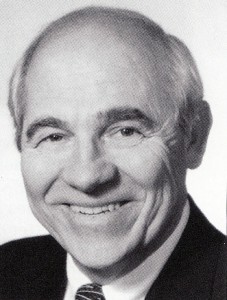 James K. Paris
James K. Paris
- Born in Franklin, Indiana in 1940
- University of Cincinnatti (1963)
Retired since 2005, Jim Paris has been a prominent Columbus architect leaving his design stamp all over the area, both in projects on his own, with partner Nolan Bingham or as a design consultant to several prominent architects who have done work here. He was an architect with Sieco in 1969-70 before beginning his own firms: The Architect Group and the Paris/Bingham partnership.
Selected Jim Paris Projects
1976: Senior Center Renovation of the old Power House building
1987: Cleo Rogers Memorial Library (addition) – also acted as a consultant to I.M. Pei on the original 1969 construction.
1990: Bartholomew County Jail (consultant to Don Hisaka)
1990: Fire Station #1 (addition) – with partner Nolan Bingham
2001: Home Federal Savings and Loan (main downtown banking center expansion)
Historic Columbus
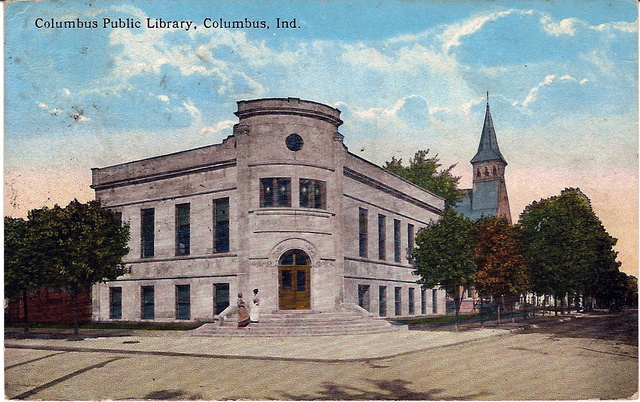
1921 view of the old Columbus Carnegie library built in 1903. It was located almost exactly where the Henry Moore sculpture now sits. The church behind the library was the former home of the First Christian Church congregation.
(postcard view, used pending permission)
Links/References
Pei Cobb Freed & Partners: I.M Pei website
Bartholomew County Public Library
City of Columbus: official City of Columbus website
Columbus Indiana Architectural Archives
Columbus Indiana Architecture Digital Archives: A small portion of the Columbus Indiana Architectural Archives available online from the IUPUI digital library
3D Models of Columbus Architecture Executed in Google SketchUp:
The Republic Newspaper – Columbus, Indiana newspaper
Bartholomew County Public Library
Historic Columbus Website – David Sechrest’s tribute to Columbus History
Historic Columbus Message Board – a companion interactive forum to the David Sechrest historical website
Bartholomew County Historical Society
 Click HERE for a Calendar of Upcoming Events in the Columbus Area.
Click HERE for a Calendar of Upcoming Events in the Columbus Area.
Click HERE for information about Tours of Columbus Architecture and Design including the Miller House.
 Ricky Berkey
Ricky Berkey
Email me: rickyberkey@gmail.com
